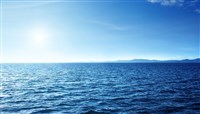
BY HASAN MURAT SÜMER (EE/IV)
hasan.sumer@ug.bilkent.edu.tr
The sea has been an essential figure in art, most probably since the humans discovered what art is. The sea is the source of life, and it’s practically endless. It is beautiful, adventurous, calm, romantic, depressing and dangerous: if you don’t approach it properly, you’ll die. In general, the sea is a mirror: it is the properties and emotions of the one who looks at it. Surely the music artist can’t create the perfect sea, since his building blocks consist only of titles, lyrics, water sounds, seagull sounds and perhaps a few visual components (covers, video clips, opera sets, etc.). So even though I’ve written this introduction with reference to the sea, I’m going to discuss some songs where the theme may be any kind of water; even a pond would do.
Ocean Cloud – Marillion
The 18-minute-long “Ocean Cloud” is available on the double CD version of the album “Marbles” (2004). The song is dedicated to Don Allum, the first person to row across the Atlantic Ocean in both directions. Marillion’s style is divided into two eras, corresponding to the vocalist at the time: the “Fish era” (pre-1989) and the “Hogarth era” (post-1989). The Fish-era Marillion is sometimes criticized for sounding very similar to Genesis, and Fish sounding exactly like Peter Gabriel doesn’t help. The Hogarth-era Marillion doesn’t suffer from this issue, and its music is generally much more accessible. “Ocean Cloud” is one of the finest outputs of the Hogarth era. When I discovered this monster, I fell in love with the lyrics and guitar work immediately. Steve Rothery, the only constant member of the band throughout its existence, is more of a soloist-type guitarist. During the vocal parts, he prefers to stay in the background and play some rhythmic bits that harmonize with the vocals, but when his time to shine arrives, he shines like the sun. There is a clear David Gilmour influence in his solos, and this is more noticeable in the Hogarth era: Rothery knows just what note to hit to induce a specific mood, and in fact he is technically stronger than Gilmour; it’s like he’s a better version of the latter. Being a lengthy track, “Ocean Cloud” includes a lot of mood changes, and it’s the guitar that produces the best of these mood-changing parts. What primarily creates differing moods in the first place is Hogarth’s singing. His lyrics about the sea are absolutely great, plus he is amazing at vocalizing them. Listen to only the first six minutes of the song, which is mellow at first and then features two choruses with an intense Rothery solo between them, and you’ll understand exactly what I meant in these last sentences, and why it’s so easy to fall in love with this song.
Spirit of The Water – Camel
This is one of those bridge tracks that are used to give a short break between two ambitious songs on an album, in this case “Moonmadness” (1976). Here, we have a very simple recorder melody and a brief yet meaningful set of lyrics, on top of a fine piano melody. This one makes you doleful, and I think the reason for this is how they have managed the vocals: they are distorted in such a way that it sounds as if the singer is at the bottom of a well and you’re at the surface, listening. The result is a short, melancholic ballad with lyrics that can be interpreted emotionally and/or philosophically.
Islands – King Crimson
Among the infinitely many King Crimson songs, the ones from the album “Islands” (1971) are unique in their stylistic spectrum. The title song is a mellow, nine-minute-long track. Its lyrics are poetically so great they don’t even need music. But they have music, which makes them even greater. It’s really easy to get into this song, even during the first listening. The structure is as follows: there is a constant, underlying piano part in classical style, and everything else is placed on top of it, mostly sequentially: we listen to some singing, accompanied by the bass flute; then we hear a cornet solo; then comes the singing again; then an oboe; then the oboe and singing together; etc. So except for the ending, which puts everything together, the song can actually be described as a musicalized poem. Solitude is the dominant theme of the lyrics; they are vocalized softly and smoothly, and every instrument follows the same style, with nothing fast or intense. A clichéd thing for the enthusiast and imaginative listener to do is to picture himself on the seashore, and let the physical components of the scene be determined by the moods of the instrumental passages: is the sea serene or are there big waves, is the sky blue or is it sunset, are there loved ones waiting for you at home or is there even a home to return to in the first place?
The difference between “Ocean Cloud” and “Islands” lies in the nature of the interaction with the sea. In “Ocean Cloud,” you sail on the sea and pay the price of challenging it by not knowing whether you’ll survive or not. In “Islands,” you stay on the shore and are safe, but each wave takes a part of you away, never to give it back. That’s the trade-off.
